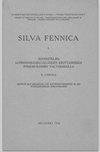添加精氨酸-磷酸对苏格兰松、挪威云杉和白桦早期存活和生长的影响
IF 1.8
3区 农林科学
Q2 FORESTRY
引用次数: 0
摘要
在树苗上施用精氨酸-磷酸(AP)是北欧一种提高森林更新成功率的新型造林方法。本文介绍了在苏格兰松(Pinus sylvestris L.)、挪威云杉(Picea abies (L.))纯种植和混合种植中添加AP对幼苗建立和伤害敏感性的潜在优势。H.喀斯特)和白桦(Betula pendula Roth)在野外种植了两年以上。研究地点位于瑞典南部(S)、东北部(NE)和西北部(NW)。南区对针叶树的主要破坏因子为松象甲(Hylobius abietis L.),北区对针叶树的主要破坏因子为桦树的啃食和针叶树的啃食。添加AP的效果因位点而异。在S点,尽管松象鼻虫对松树造成了相当大的破坏,但对松树的成活率呈阳性。然而,在S点,AP处理对幸存的云杉和桦树有更多的食用量。在NE点,AP处理对针叶树的生长有积极的影响。在西北样地,添加AP对三种植物的生存和生长都有积极的影响,并且AP处理的幼苗都比未处理的幼苗更少被浏览。AP处理是提高森林更新成功率的潜在工具,特别是在瑞典南部建立松林时。本文章由计算机程序翻译,如有差异,请以英文原文为准。
Effect of arginine-phosphate addition on early survival and growth of Scots pine, Norway spruce and silver birch
Applying arginine-phosphate (AP) to tree seedlings at planting is a novel silvicultural practice in Northern Europe to improve the success of forest regeneration. We present three case-studies of the potential advantages of adding AP at planting on the establishment and damage susceptibility of seedlings in pure and mixed plantings of Scots pine (Pinus sylvestris L.), Norway spruce (Picea abies (L.) H. Karst. ) and silver birch (Betula pendula Roth) over two years in the field. Location of study sites were in southern (S), northeastern (NE) and northwestern (NW) Sweden. The main agents of damage were pine weevil (Hylobius abietis L.) on conifers at the south site, browsing of birch at all sites and browsing/other top damage to conifers at the north sites. The effect of adding AP varied between the sites. It was positive for survival of pine at site S, despite considerable damage by pine weevil. However, at the S site more of the surviving spruce and birch were browsed when treated with AP. At the NE site AP-treatment had positive effects on conifer growth. At the NW site adding AP positively affected survival and growth of all three species, and AP-treated seedlings of all species were less browsed than untreated seedlings. AP treatment presents a potential tool to improve the success of forest regeneration, especially when establishing pine stands in south Sweden.
求助全文
通过发布文献求助,成功后即可免费获取论文全文。
去求助
来源期刊

Silva Fennica
农林科学-林学
CiteScore
3.50
自引率
11.10%
发文量
21
审稿时长
3 months
期刊介绍:
Silva Fennica publishes significant new knowledge on forest sciences. The scope covers research on forestry and forest ecosystems. Silva Fennica aims to increase understanding on forest ecosystems, and sustainable use and conservation of forest resources. Use of forest resources includes all aspects of forestry containing biomass-based and non-timber products, economic and social factors etc.
 求助内容:
求助内容: 应助结果提醒方式:
应助结果提醒方式:


